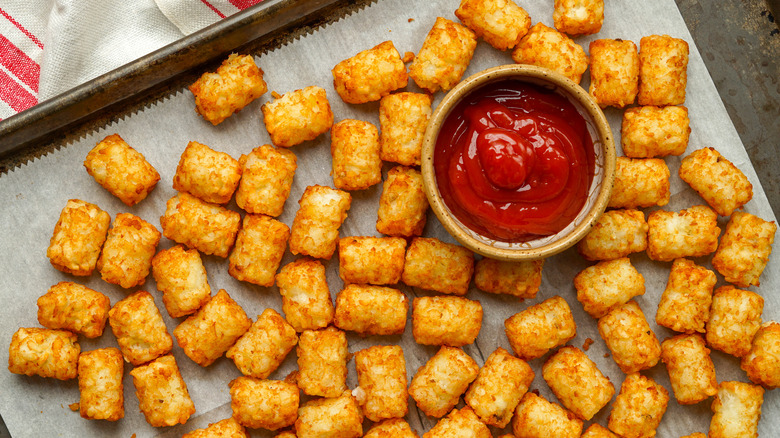The True Origin Of Tater Tots
Crispy, bite-size, and irresistibly delicious, tater tots are a common side dish or topping for burgers, a best friend to ketchup, a simple swap to french fries, and a great base for nachos. Since they come in frozen bags for easy frying and baking, these scrumptious spuds are a convenient way to round out your dinner plate. However, they're a bit tricky to make from scratch because there are many steps involved.
According to Inspired Taste, homemade tater tots require peeling your potatoes, cutting into chunks, soaking them in cold water, pulsing them in a food processor until fine, ringing out the liquid with a kitchen towel, microwaving slightly, mixing in your spices and seasonings, rolling into nugget-shaped pieces, and finally, frying or baking. This process is so involved, you can't help but wonder how it was created in the first place. Who thought to themselves: "Ah! A potato! Let's shred it up, roll it into cylinders, and fry it until crispy." Well, if you want to know the truth, F. Nephi Grigg did, and we are forever grateful for it (via Deseret News).
They were invented to reduce food waste
According to Deseret News, F. Nephi Grigg was an Idaho native and entrepreneur who invented the ever-so-famous tater tot. In 1951, he acquired a bankrupt company that we now know as Ore-Ida, which was located on the border between Idaho and Oregon (hence the name), and had the itch to transition the company from selling frozen corn to fried frozen potatoes.
According to Eater, by the time french fries were getting to be a big money maker for Ore-Ida, a machinery issue arose. When the potatoes were cut, a lot of scraps were left behind. For a while, Grigg gave them to livestock, but with the help of new machinery, they were able to smush and shape the potato scraps into tater tots and freeze them. Grigg wanted to get them on the market as soon as possible, but he had to jump through a few hoops first.
Eater states that the entrepreneur traveled nearly 3,000 miles from Oregon to Miami Beach for the 1954 National Potato Convention with a 15-pound bag of his new invention. Adamant to cook it for this large group of potato connoisseurs, he bribed the chef to let him serve his innovation. Like most plates of tater tots, they did not stay on the table for long, and Grigg's invention was off to a successful start. After trademarking the name and purchasing the right equipment, tater tots were ready to be served to the masses.

